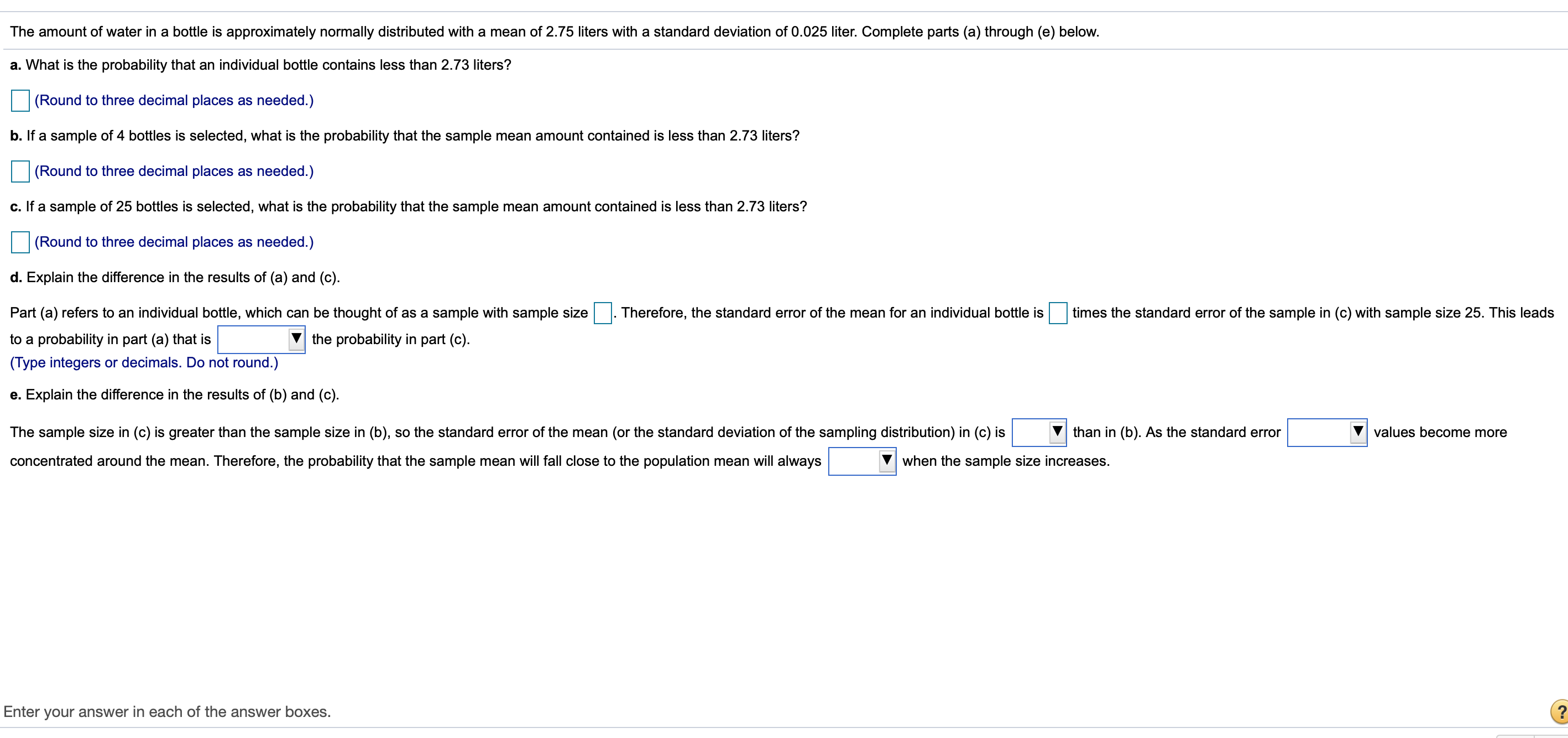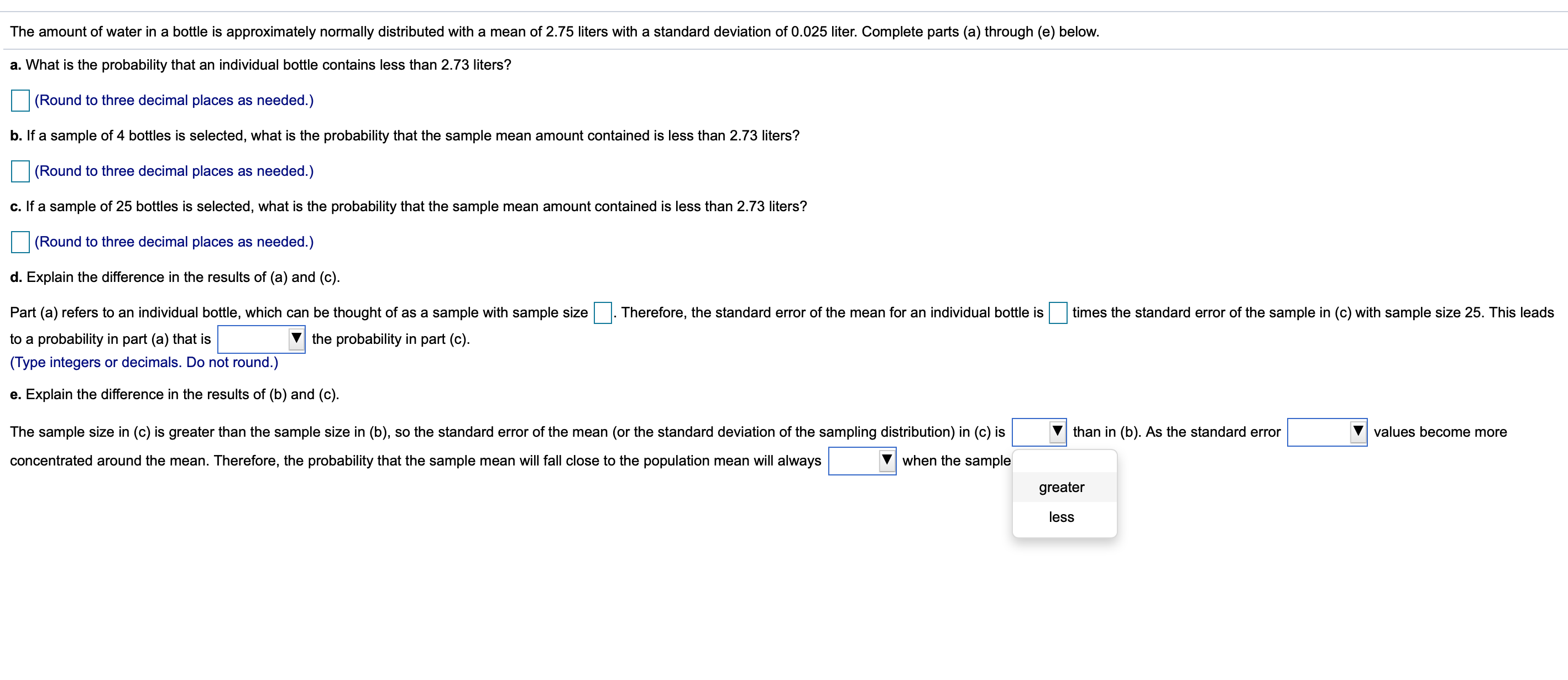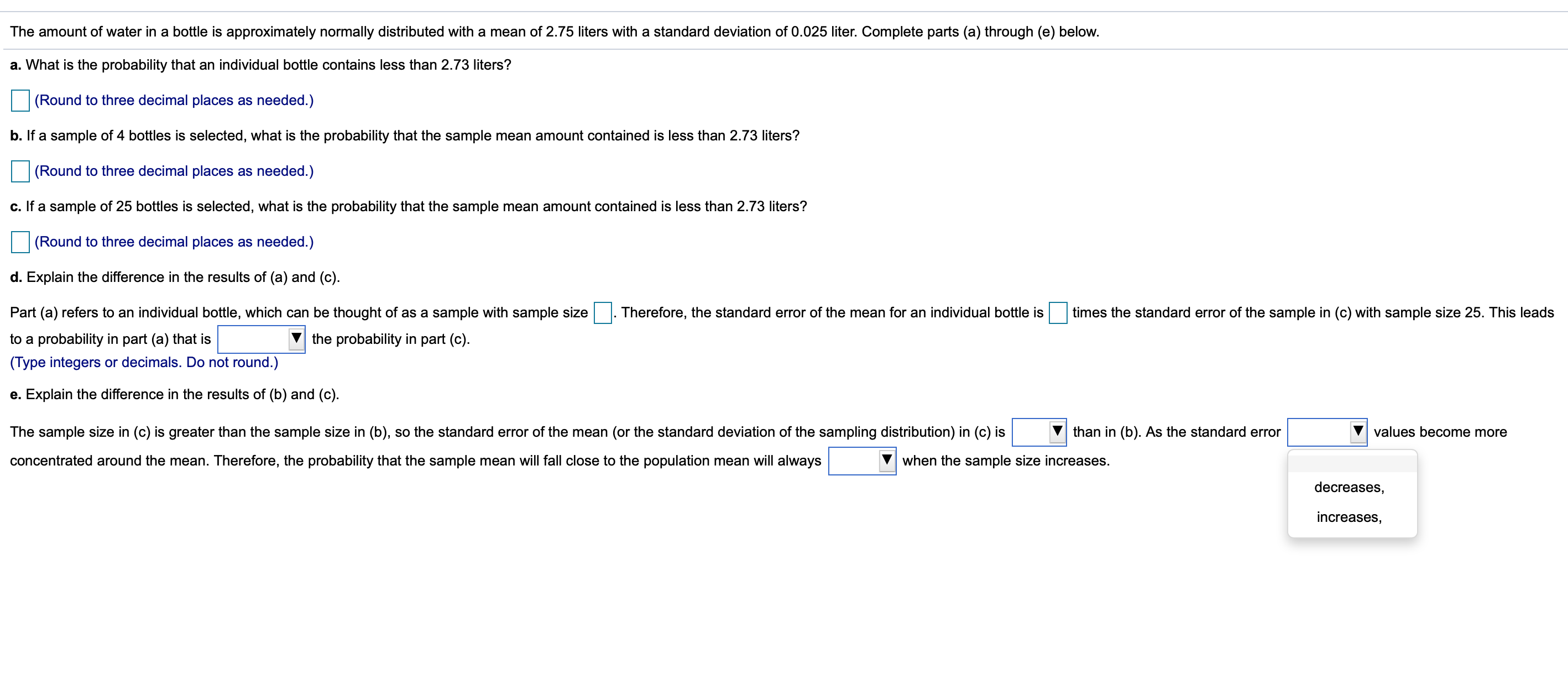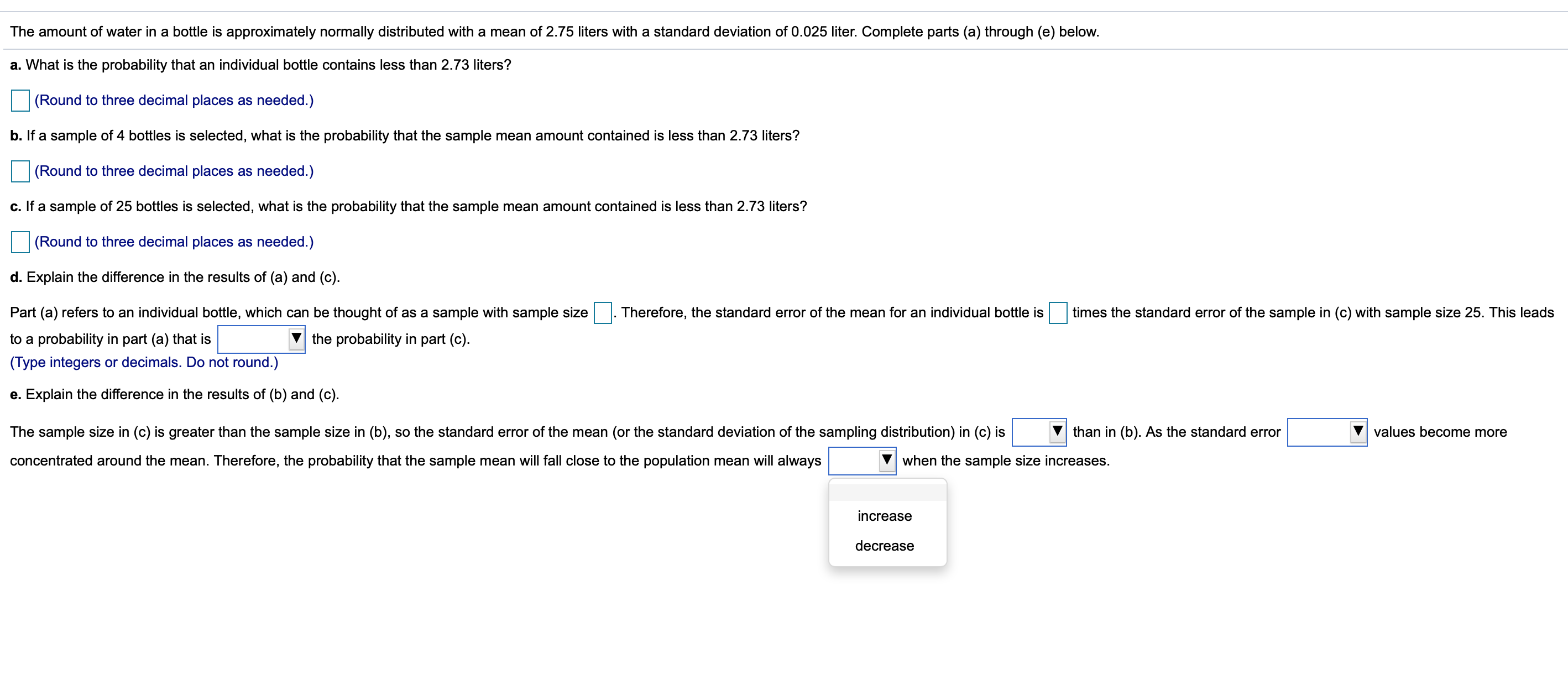Need help with questions a, b, c, d, and e ASAP. The first Screenshot is the full question, the rest of the 4 screenshots are there to show the options for the answers in the box.
The amount of water in a bottle is approximately normally distributed with a mean of 2.75 liters with a standard deviation of 0.025 liter. Complete parts (a) through (e) below. a. What is the probability that an individual bottle contains less than 2.73 liters? (Round to three decimal places as needed.) b. If a sample of 4 bottles is selected, what is the probability that the sample mean amount contained is less than 2.73 liters? (Round to three decimal places as needed.) o. If a sample of 25 bottles is selected, what is the probability that the sample mean amount contained is less than 2.73 liters? (Round to three decimal places as needed.) d. Explain the difference in the results of (a) and (c). Part (3) refers to an individual bottle, which can be thought of as a sample with sample size . Therefore, the standard error of the mean for an individual bottle is times the shndard error of the sample in (c) with sample size 25. This leads to a probability in part (a) that is l the probab ty in part (c). (Type integers or decimals. Do not round.) 9. Explain the difference in the results of (b) and (o). The sample size in (c) is greater than the sample size in (b), so the standard error of the mean (or the standard deviation of the sampling distribution) in (c) is 'V than in (b). As the standard error V values become more concentrated around the mean. Therefore, the probability that the sample mean will fall close to the population mean will always Enter your answer in each of the answer boxes. 7 when the sample size increases. The amount of water in a bottle is approximately normally distributed with a mean of 2.75 liters with a standard deviation of 0.025 liter. Complete parts (a) through (e) below. a. What is the probability that an individual bottle contains less than 273 liters? (Round to three decimal places as needed.) b. If a sample of 4 bottles is selected, what is the probability that the sample mean amount contained is less than 2.73 liters? (Round to three decimal places as needed.) c. If a sample at 25 bottles is selected, what is the probability that the sample mean amount contained is less than 2.73 liters? (Round to three decimal places as needed.) d. Explain the difference in the results of (a) and (c). Part (a) refers to an individual bottle, which can be thought of as a sample with sample size . Theretore, the standard error of the mean for an individual bottle is times the standard error of the sample in (c) with sample size 25. This leads to a probability in part (a) that is l: the probability in part (c). (Type integers or decimals. Do n e. Explain the dilterenoe in the re the same as larger than The sample size in (c) is greater n (b), so the standard error of the mean (or the standard deviation of the sampling distribution) in (c) is 1V than in (b). As the standard error E values become more smaller than concentrated around the mean. ' lity that the sample mean will fall close to the population mean will always V when the sample size increases. The amount of water in a bottle is approximately normally distributed with a mean of 2.75 liters with a standard deviation of 0.025 liter. Complete parts (a) through (e) below. a. What is the probability that an individual bottle contains less than 273 liters? (Round to three decimal places as needed.) (Round to three decimal places as needed.) (Round to three decimal places as needed.) d. Explain the difference in the results of (a) and (0). Part (a) refers to an individual bottle, which can be thought of as a sample with sample size to a probability in part (a) that is l: the probability in part (c). (Type integers or decimals. Do not round.) e. Explain the dilterenoe in the results of (b) and (c). b. If a sample of 4 bottles is selected, what is the probability that the sample mean amount contained is less than 2.73 liters? c. If a sample of 25 bottles is selected, what is the probability that the sample mean amount contained is less than 2.73 liters? . Theretore, the standard error of the mean for an individual bottle is times the standard error of the sample in (c) with sample size 25. This leads The sample size in (c) is greater than the sample size in (b), so the standard error of the mean (or the standard deviation of the sampling distribution) in (c) is '1 than in (b). As the standard error E values become more concentrated around the mean. Therefore, the probability that the sample mean will fall close to the population mean will always V when the sample greater I855 The amount of water in a bottle is approximately normally distributed with a mean of 2.75 liters with a standard deviation of 0.025 liter. Complete parts (a) through (e) below. a. What is the probability that an individual bottle contains less than 273 liters? (Round to three decimal places as needed.) (Round to three decimal places as needed.) (Round to three decimal places as needed.) d. Explain the difference in the results of (a) and (0). Part (a) refers to an individual bottle, which can be thought of as a sample with sample size to a probability in part (a) that is l: the probability in part (c). (Type integers or decimals. Do not round.) e. Explain the dilterenoe in the results of (b) and (c). The sample size in (c) is greater than the sample size in (b), so the standard error of the mean (or the standard deviation of the sampling distribution) in (c) is b. If a sample of 4 bottles is selected, what is the probability that the sample mean amount contained is less than 2.73 liters? c. If a sample of 25 bottles is selected, what is the probability that the sample mean amount contained is less than 2.73 liters? . Theretore, the standard error of the mean for an individual bottle is times the standard error of the sample in (c) with sample size 25. This leads than in (b). As the standard error E values become more concentrated around the mean. Therefore, the probability that the sample mean will fall close to the population mean will always V when the sample size increases. decreases. increases. The amount of water in a bottle is approximately normally distributed with a mean of 2.75 liters with a standard deviation of 0.025 liter. Complete parts (a) through (e) below. a. What is the probability that an individual bottle contains less than 273 liters? (Round to three decimal places as needed.) b. If a sample of 4 bottles is selected, what is the probability that the sample mean amount contained is less than 2.73 liters? (Round to three decimal places as needed.) c. If a sample at 25 bottles is selected, what is the probability that the sample mean amount contained is less than 2.73 liters? (Round to three decimal places as needed.) d. Explain the difference in the results of (a) and (c). Part (a) refers to an individual bottle, which can be thought of as a sample with sample size . Theretore, the standard error of the mean for an individual bottle is times the standard error of the sample in (c) with sample size 25. This leads to a probability in part (a) that is l: the probability in part (c). (Type integers or decimals. Do not round.) e. Explain the dilterenoe in the results of (b) and (c). The sample size in (c) is greater than the sample size in (b), so the standard error of the mean (or the standard deviation of the sampling distribution) in (c) is '1 than in (b). As the standard error E values become more concentrated around the mean. Therefore, the probability that the sample mean will fall close to the population mean will always 1 when the sample size increases. increase decrease











